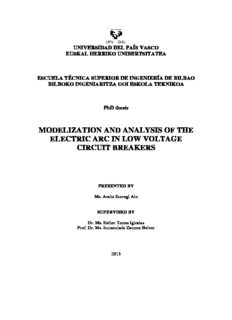Table Of ContentUNIVERSIDAD DEL PAÍS VASCO
EUSKAL HERRIKO UNIBERTSITATEA
ESCUELA TÉCNICA SUPERIOR DE INGENIERÍA DE BILBAO
BILBOKO INGENIARITZA GOI ESKOLA TEKNIKOA
PhD thesis
MODELIZATION AND ANALYSIS OF THE
ELECTRIC ARC IN LOW VOLTAGE
CIRCUIT BREAKERS
PRESENTED BY
Ms. Araitz Iturregi Aio
SUPERVISED BY
Dr. Ms. Esther Torres Iglesias
Prof. Dr. Ms. Inmaculada Zamora Belver
2013
“Insanity: doing the same thing over and over again
expecting different results”
Albert Einstein
ACKNOWLEDGEMENTS
To my thesis directors, Dr.Ms. Esther Torres and Prof. Dr. Ms. Inmaculada Zamora,
for all the help and support provided.
To the whole department of Elektrische Geräte und Anlagen at Technische
Universität Ilmenau and especially to Prof. Frank Berger and Dipl.-Ing. Bogdan Barbu
for the opportunity to work with them and all the help provided.
Technical and human support provided by IZO-SGI, SGIker (UPV/EHU, MICINN, GV/EJ,
ERDF and ESF) is gratefully acknowledged.
To my colleagues and all the people that had helped me selflessly.
Lagunei, bereziki Oihaneri.
Etxekoei, erortzerakoan altxatu eta aurrera jarraitzen irakasteagatik.
Aitorri, bihotzez.
INDEX i
Index of contents
1 INTRODUCTION .............................................................................. 3
1.1 BACKGROUND ............................................................................................................... 3
1.2 AIM OF THE DOCTORAL THESIS ..................................................................................... 4
1.3 STRUCTURE OF THE DOCTORAL THESIS ........................................................................ 4
2 ELECTRIC ARC PHENOMENON .............................................................. 9
2.1 INTRODUCTION ............................................................................................................. 9
2.2 GENERAL ASPECTS OF THE ELECTRIC ARC ..................................................................... 9
2.2.1 FORMATION AND MAINTENANCE OF THE ELECTRIC ARC.................................... 9
2.2.2 CHARACTERISTICS OF THE ELECTRIC ARC ........................................................... 12
2.3 INTERRUPTION OF THE ELECTRIC ARC ........................................................................ 17
2.3.1 DC INTERRUPTION .............................................................................................. 17
2.3.2 AC INTERRUPTION .............................................................................................. 18
2.4 INTERRUPTION OF THE ELECTRIC ARC IN AIR ............................................................. 18
2.5 CONCLUSIONS ............................................................................................................. 19
3 LOW VOLTAGE CIRCUIT BREAKERS ....................................................... 23
3.1 INTRODUCTION ........................................................................................................... 23
3.2 INTERRUPTION TECHNOLOGIES IN LVCBs ................................................................... 23
3.2.1 CONVENTIONAL LVCB ........................................................................................ 24
3.2.1.1 Miniature Circuit Breaker (MCB) ..................................................................... 25
3.2.1.2 Molded Case Circuit Breaker (MCCB) .............................................................. 25
3.2.1.3 Low Voltage Power Circuit Breaker (LVPCB) ................................................... 26
3.2.2 STATIC RUPTURE ................................................................................................. 27
3.2.3 OTHER CONFIGURATIONS ................................................................................... 28
3.3 INFLUENCE OF THE LVCBs’ COMPONENTS IN THE INTERRUPTION PROCESS ............. 28
3.3.1 ARC CHAMBER .................................................................................................... 29
3.3.1.1 Geometry of the splitter plates ...................................................................... 29
3.3.1.2 Arrangement and quantity of splitter plates.................................................. 33
3.3.1.3 Material .......................................................................................................... 37
3.3.2 ELECTRICAL CONTACTS ....................................................................................... 39
3.4 CONCLUSIONS ............................................................................................................. 41
ii INDEX
4 MODELS FOR THE ANALYSIS OF THE ELECTRIC ARC IN LOW VOLTAGE CIRCUIT
BREAKERS ......................................................................................... 45
4.1 INTRODUCTION ........................................................................................................... 45
4.2 TYPES OF MODELS ....................................................................................................... 46
4.2.1 BLACK BOX MODELS ............................................................................................ 47
4.2.2 MODELS BASED ON GRAPHICS AND DIAGRAMNS ............................................. 51
4.2.3 PHYSICAL MODELS .............................................................................................. 53
4.2.3.1 Magnetohydrodynamic (MHD) description ........................................................ 55
4.2.3.2 Radiation ............................................................................................................. 60
4.2.3.3 Arc roots .............................................................................................................. 63
4.3 STATE OF THE ART OF PHYSICAL MODELS FOR LVCBS ................................................ 64
4.3.1 MAGNETIC FIELD AND MAGNETIC FORCES CALCULATION ON THE ARC ........... 65
4.3.2 MAGNETOHYDRODYNAMIC MODELS ................................................................ 71
4.3.2.1 Academic models ................................................................................................ 72
4.3.2.2 Manufacturers’ models ..................................................................................... 101
4.3.2.3 Comparison ....................................................................................................... 109
4.4 CONCLUSIONS ........................................................................................................... 112
5 NEW MODEL FOR ANALYSING THE ELECTRIC ARC .................................... 117
5.1 INTRODUCTION ......................................................................................................... 117
5.2 SOFTWARE TOOL ....................................................................................................... 118
5.3 DESCRIPTION OF THE NEW MODEL .......................................................................... 124
5.3.1 GEOMETRY ............................................................................................................... 126
5.3.2 MESH ........................................................................................................................ 129
5.3.3 DEFINITION OF DOMAINS AND BOUNDARY CONDITIONS ....................................... 131
5.3.4 PARAMETERIZATION ................................................................................................ 134
5.4 SIMULATION RESULTS ............................................................................................... 137
5.4.1 CASE A: BASE MODEL ........................................................................................ 138
5.4.1.1 Case A.1: V-J arc root curve for 10V Peak ..................................................... 139
5.4.1.2 Case A.2: V-J arc root curve for 17.1V peak .................................................. 142
5.4.1.3 Case A.3: V-J arc root curve for 19.7V peak .................................................. 143
5.4.1.4 Case A.4: V-J arc root curve for 22.3V peak .................................................. 144
5.4.1.5 Comparative analysis .................................................................................... 145
5.4.2 CASE B: SPLITTER PLATES .................................................................................. 148
INDEX iii
5.4.2.1 Case B.1: Zero splitter plates (0SP) ............................................................... 148
5.4.2.2 Case B.2: Two splitter plates (2SP) ................................................................ 149
5.4.2.3 Comparative analysis .................................................................................... 150
5.4.3 CASE C: LOWER ARC IGNITION AND DIFFERENT INPUT CURRENTS .................. 153
5.4.3.1 Case C.1: Lower arc ignition, 50A input current and 0SP .............................. 153
5.4.3.2 Case C.2: Lower arc ignition, 50A input current and 1SP .............................. 154
5.4.3.3 Case C.3: Lower arc ignition, 100A input current and 0SP ............................ 155
5.4.3.4 Case C.4: Lower arc ignition, 100A input current and 1SP ............................ 156
5.4.3.5 Case C.5: Lower arc ignition, 200A input current and 0SP ............................ 157
5.4.3.6 Case C.6: Lower arc ignition, 200A input current and 1SP ............................ 158
5.4.3.7 Comparative analysis .................................................................................... 159
5.4.4 CASE D: EXPANSION VOLUME ........................................................................... 160
5.4.4.1 Case D.1: Expansion volume, base case ........................................................ 162
5.4.4.2 Case D.2: Expansion volume, higher air down wall ....................................... 163
5.4.4.3 Case D.3: Expansion volume, longer electrodes ........................................... 164
5.4.4.4 Comparative analysis .................................................................................... 165
5.4.5 CASE E: ARC ROOTS ........................................................................................... 166
5.4.5.1 Case E.1: Constant Ohmic resistance ............................................................ 166
5.4.5.2 Comparative analysis .................................................................................... 167
5.5 CONCLUSIONS ........................................................................................................... 168
6 VERIFICATION AND VALIDATION OF THE NEW MODEL ............................... 173
6.1 INTRODUCTION ......................................................................................................... 173
6.2 VERIFICATION ............................................................................................................ 174
6.2.1 METHODOLOGY ....................................................................................................... 174
6.2.2 VERIFICATION RESULTS ............................................................................................ 176
6.2.2.1 Mesh density influence ..................................................................................... 176
6.2.2.2 Timestep influence ............................................................................................ 181
6.3 VALIDATION ............................................................................................................... 186
6.3.1 LABORATORY SETUP .......................................................................................... 186
6.3.2 VALIDATION RESULTS ........................................................................................ 189
6.3.2.1 Test 1: 50A, 0SP ............................................................................................. 189
6.3.2.2 Test 2: 50A, 1SP ............................................................................................. 191
6.3.2.3 Test 3: 100A, 0SP ........................................................................................... 192
iv INDEX
6.3.2.4 Test 4: 100A, 1SP ........................................................................................... 193
6.3.2.5 Test 5: 200A, 0SP ........................................................................................... 194
6.3.2.6 Test 6: 200A, 1SP ........................................................................................... 196
6.4 CONCLUSIONS ........................................................................................................... 197
7 CONCLUSIONS AND FUTURE WORK .................................................... 201
7.1 CONCLUSIONS OF THE THESIS ................................................................................... 201
7.2 FUTURE WORK .......................................................................................................... 203
REFERENCES .................................................................................... 207
ANNEX ........................................................................................... 217
Description:“Insanity: doing the same thing over and over again The circuit breaker can be defined as an electrical device designed for interruption of the.

